
King crabs are decapod crustaceans in the family Lithodidae that are chiefly found in deep waters. King crabs are not true crabs and are generally thought to be derived from hermit crab ancestors within the Paguridae, which may explain the asymmetry still found in the adult forms. This ancestry is supported by several anatomical peculiarities which are present only in king crabs and hermit crabs. Although some doubt still exists about this hypothesis, king crabs are the most widely quoted example of carcinisation among the Decapoda. Several species of king crabs, especially in Alaskan and southern South American waters, are targeted by commercial fisheries and have been subject to overfishing.

Xanthidae is a family of crabs known as gorilla crabs, mud crabs, pebble crabs or rubble crabs. Xanthid crabs are often brightly coloured and are highly poisonous, containing toxins which are not destroyed by cooking and for which no antidote is known. The toxins are similar to the tetrodotoxin and saxitoxin produced by puffer fish, and may be produced by bacteria in the genus Vibrio living in symbiosis with the crabs, mostly V. alginolyticus and V. parahaemolyticus.

Pinnotheres is a genus of crabs, including the pea crab. Many species formerly in Pinnotheres have been placed in new genera, such as Zaops ostreus, the oyster crab and Nepinnotheres novaezelandiae, the New Zealand pea crab. The species currently recognised in the genus Pinnotheres are:
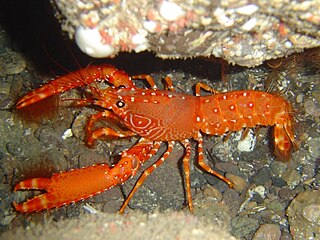
Reef lobsters, Enoplometopus, are a genus of small lobsters that live on reefs in the Indo-Pacific, Caribbean and warmer parts of the Atlantic Ocean.
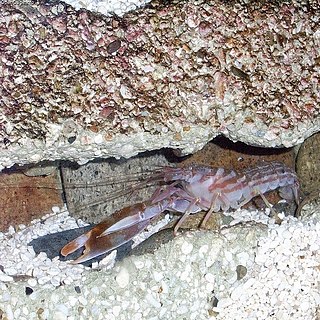
Alpheus is a genus of snapping shrimp of the family Alpheidae. This genus contains in excess of 330 species, making this the most species-rich genus of shrimp. Like other snapping shrimp, the claws of Alpheus are asymmetrical, with one of the claws enlarged for making a popping noise. Some species in the genus enter into symbiotic relationships with gobiid fishes, and others associate with sea anemones.

Macrophthalmus is a genus of crabs which are widespread across the Indo-Pacific. It contains the following species : Species in this genus are often referred to as sentinel crabs.
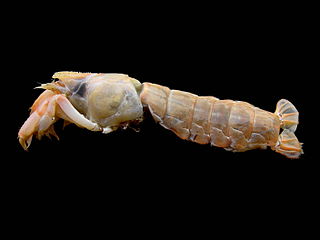
Upogebia is a genus of mud shrimp, in the family Upogebiidae, containing the following species:
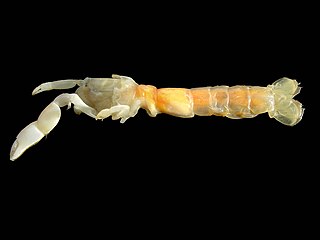
Callianassidae is a family of ghost shrimp crustaceans belonging to the infraorder Axiidea, within the order Decapoda.
Callianassa is a genus of mud shrimps, in the family Callianassidae. Three of the species in this genus have been split off into a new genus, Pestarella, while others such as Callianassa filholi have been moved to Biffarius. The genus is named after the Nereid of the Greco-Roman mythology.

Filhollianassa filholi is a ghost shrimp of the family Callianassidae, endemic to New Zealand, which grows up to 60 mm (2.4 in) long. It was known as Biffarius filholi until a 2019 taxonomic revision of the group.
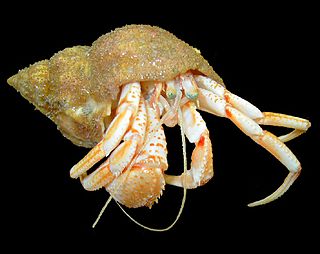
The Paguridae are a family of hermit crabs of the order Decapoda. The king crabs, Lithodidae, are now widely understood to be derived from deep within the Paguridae, with some authors placing their ancestors within the genus Pagurus.

Palaemon is a genus of caridean shrimp in the family Palaemonidae.

Gilvossius tyrrhenus is a species of mud shrimp which grows to a length of 70 mm (2.8 in). It lives in burrows in shallow sandy parts of the sea-bed in the Mediterranean Sea and northern Atlantic Ocean. It is the most common thalassinidean in the Mediterranean, and has been used as bait by fishermen for at least 200 years.

Neotrypaea is a genus of ghost shrimp in the family Callianassidae, containing the following sixteen species:
Biffarius is a genus of ghost shrimp in the family Callianassidae, containing species formerly included in the genus Callianassa. Its members are small and generally live in the intertidal zone. In April 2020, a new species was described from the northeastern Brazilian coast. Biffarius was named in honour of Thomas A. Biffar, and includes the following species:

Lepidophthalmus is a genus of ghost shrimp.

Ebalia is a genus of crab in the family Leucosiidae.

Metapenaeus is a genus of prawns, containing the following species:

Callichirus is a genus of crustaceans belonging to the family Callianassidae. It was circumscribed by William Stimpson in 1866.

Daldorfia is a genus of parthenopid crab, belonging to the subfamily Daldorfiinae.

















